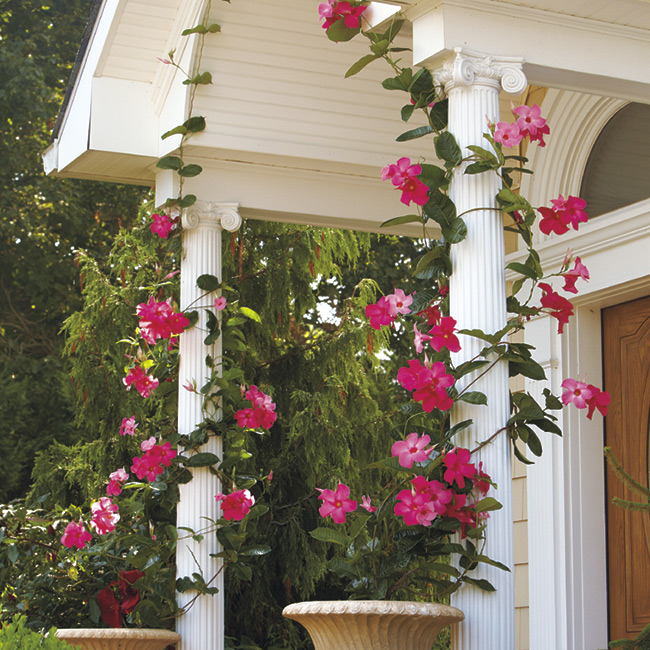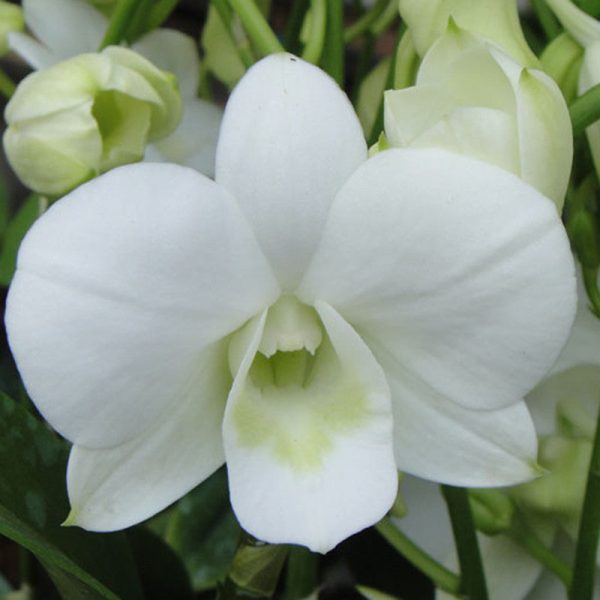One grower calls mandevilla “the fleur with allure.” Talk about truth in advertising! And even though it isn’t cold-hardy in most of North America, anyone can grow it as an annual and it’ll bloom from late spring to fall.
Mandevilla is a well-behaved twining vine. That means it won’t outgrow its space and strangle nearby plants. Give it some support or stems will twine around themselves and splay in different directions, making it look messy. Obelisks and trellises are perfect for keeping mandevilla looking neater.
How to grow mandevilla
Mandevillas thrive in warm, humid weather and bloom continuously from late spring until frost. They are best purchased as potted plants. Wait until temperatures are reliably in the 60 degree F daytime temperature range (50 degrees F at night) before you plant them outdoors.
Find a spot for mandevilla with at least six hours of sun each day, although in hot climates, a little afternoon shade is helpful. Keep mandevilla well-watered and fertilize once in spring with a balanced, slow-release fertilizer, such as 14-14-14.
Design with mandevilla
Here are three ways to bring this hard-working plant into your garden:
 With a mature height of 15 to 20 feet, ‘Alice du Pont’ has the size to make an impression.
With a mature height of 15 to 20 feet, ‘Alice du Pont’ has the size to make an impression.
1. Use mandevilla in entries
Witness the twin urn-grown specimens making a display on these entryway columns in the photo above. Fishing line tied loosely along the columns helps the mandevilla navigate its way up the pillars. (This step isn’t necessary when mandevilla is grown on a narrow post or a gridlike structure because it will twine easily around a smaller support.) To get this much growth in a single season, start with the biggest plants you can find.
Occasionally, you may need to direct the mandevilla vine away from the chain to keep it trailing instead of climbing.
2. Use mandevilla in a hanging basket
Buy a small cultivar, such as the mounding deep magenta vine in the photo above, and you may find yourself using mandevilla in an unexpected way. With summer-long blooming tendencies to rival any bedding annual, a smaller cultivar of mandevilla makes a fine addition to a hanging basket. And at 18 to 36 inches long, the mounding form won’t overtake its companions. Here, a 1-gallon pot of mandevilla was added to a burgundy alternanthera (Alternanthera hybrid) and variegated airplane plant (Chlorophytum comosum ‘Variegatum’), each in a 4-inch pot.
Sun Parasol Giant White mandevilla grows 10 to 15 feet tall. In this pot it’s paired with ‘Georgia Peach’ coral bells.
3. Grow mandevilla in a colorful container
When your flower border starts to fade, add color fast with a flashy container of mandevilla. Train it on a small obelisk and it’ll give you height and color. Look how this blue pot of Sun Parasol® Giant White mandevilla takes your attention away from the fading spirea (Spiraea spp. & hybrids) blooms behind it and adds height to the lower growing salvias (Salvia farinacea).
Hide a brick wall with vining mandevilla.
4. Cover a wall with mandevilla
Got a big bare wall? Try growing mandevilla on a trellis for a dramatic splash of color in a hurry. Plant mandevilla vines along a wire fence panel for a temporary privacy panel or to divide the backyard into “garden rooms.”
How to overwinter mandevilla
Save money next year by bringing a tender mandevilla plant indoors this winter instead of letting it die. Here’s how to overwinter a mandevilla:
- About three weeks before 40-degree nighttime temperatures are predicted, feed mandevilla a high-phosphorous liquid fertilizer, such as 10-56-14, at half strength. (The middle number represents phosphorous, which promotes healthy roots.)
- When temperatures start to drop to about 50 degrees F at night but still in the 60’s during the day, scale back on watering.
- As temperatures dip regularly below 50 degrees F at night but before it freezes, cut the mandevilla vine back to about 12 inches above the soil line.
- Wash mandevilla foliage thoroughly with mild dish soap and rinse with water to remove any insects, or spray with insecticidal soap.
- Move it into a cool basement, garage or crawl space that maintains a winter temperature above freezing — around 50 to 60 degrees F is ideal.
- Because it will go dormant, supplemental light isn’t necessary.
- Water lightly every 5 to 6 weeks so the soil stays on the dry side, but don’t fertilize.
- In early spring the plant will start to form new shoots. Keeping it indoors, move it to a sunny window and pinch the growing tips to form a bushier vine.
- Wait until all chance of frost has passed and nighttime temps stay above 50 degrees F before moving it outside.
Mandevilla cultivars to try
It seems as though every year there are new colors (shades of red, pink, white, apricot, or yellow) and forms of mandevilla being introduced to the market. Be sure to check the mature size and form before you buy so you can select the right one for your needs.







Reviews
There are no reviews yet.